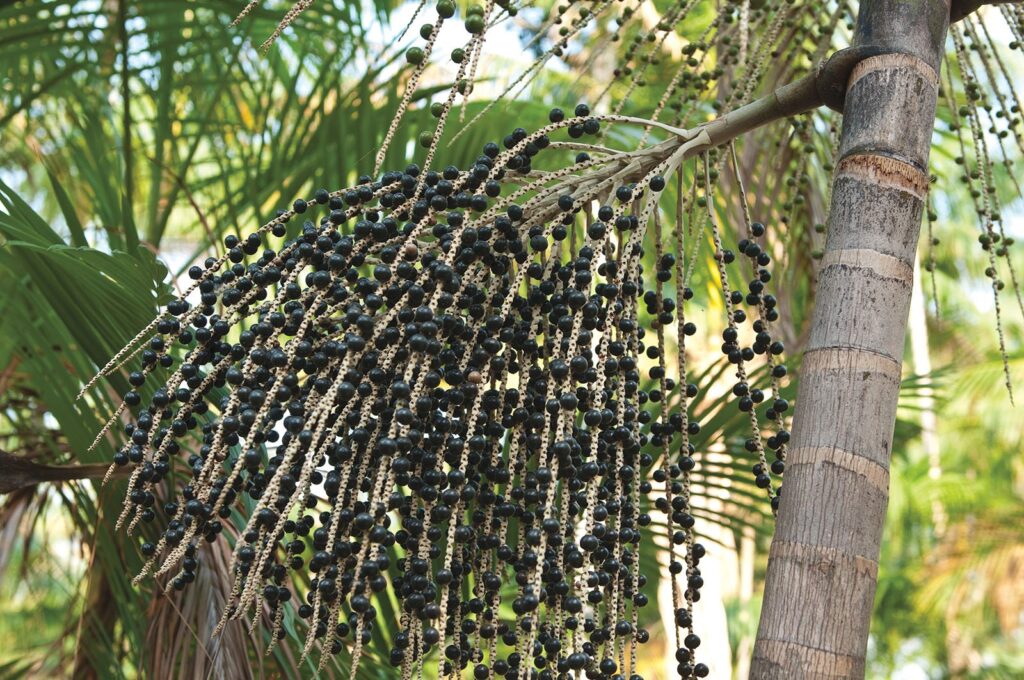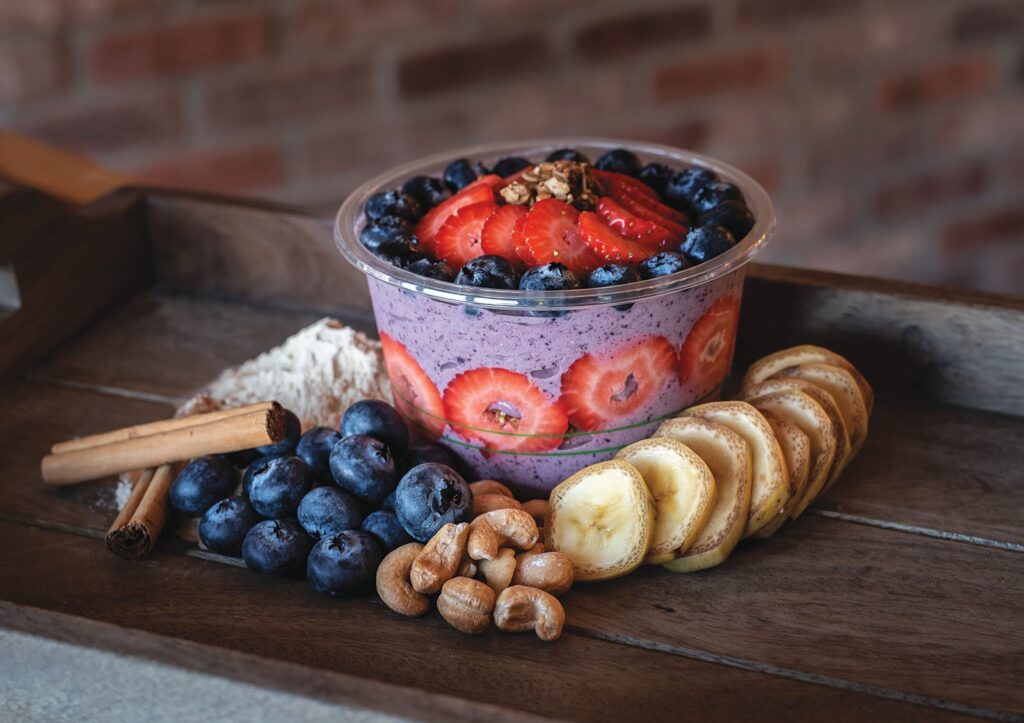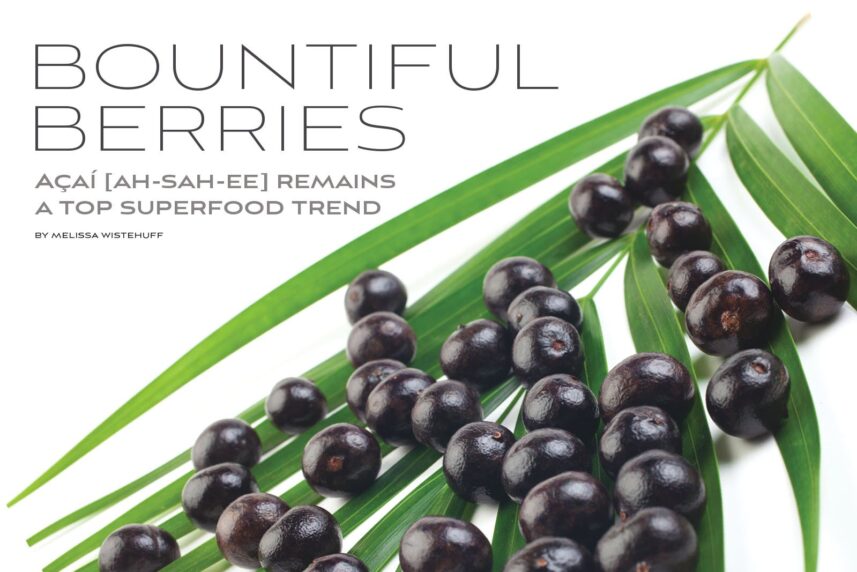Article:
Widely touted as one of nature’s most nutritionally dense superfoods, the açaí (pronounced ah-sah-ee) berry primarily hails from the Brazilian Amazon rainforest, since it can only grow near the equator. This nutrient-rich, deep purple–hued berry has been used for medicinal purposes for thousands of years and is rich in antioxidants—a substance that helps delay or prevent heart disease, cancer and other ailments. Açaí berries are also known to boost the immune system, fight inflammation and prevent infections. Piled, mixed or blended with a heap of other succulent toppings, açaí berries create healthy meals that taste like desserts, establishing them as a delicious and nutritious superfood trend that is here to stay.
Berry Good
Açaí berries grow from a clump of branches that sprout beneath the fronds of Central and South American palm trees. Each thin branch contains hundreds of small, round fruits, as if strung like beads on a necklace. The berries resemble blueberries, but are deeper in color and hard as a rock. A traditional population of people known as the ribeirinhos, who live along the rivers of the Amazon delta, pick the berries by hand. They harvest and prepare them the same way they have done it for centuries—by shimmying up the long trunk of the tree and cutting the bunches from the top of the palm with a blade. Each palm tree is capable of producing over 40 pounds of fruit per year.
Because the berry is hard, it isn’t palatable in raw form and must be soaked in water to soften the flesh. The ribeirinhos must remove the large pit, or seed, before the berries can be consumed. Once they harvest the açaí into baskets and trucks for commercial use, the berries must be produced or frozen no longer than 24 hours after they have been picked. By the time the berries reach local supermarkets, they have most likely been pureed for the freezer section, or converted into a powder for use in capsules, candies or juice.
Coming to America
Until the late 21st century, very little was known about açaí berries outside of South America. According to City Bowls, a chain of health food cafes based in Alabama, legendary coach and founder of Brazilian jiujitsu Carlos Gracie realized the tremendous health benefits of the açaí berry during the 1970s, and introduced an açaí/banana blend as part of his recommended nutrition plan for athletes. This became known as the “Gracie Diet.” His healthy smoothie bowl began making its way to the Brazilian masses.
Açaí’s rise to popularity in the U.S. can be credited to brothers Ryan and Jeremy Black and their friend, Ed Nichols—three American surfers from California who were introduced to the açaí bowl during a 1999 vacation in Brazil. According to a May 9, 2022 Forbes article, Ryan Black, also a former pro football player, tried an açaí bowl during that 1999 vacation. In 2000, he, his brother and Nichols founded SAMBAZON, a company based in San Clemente, California that makes and sells açaí-based foods and beverages. Throughout the course of the next 10 years, SAMBAZON pioneered the process of certifying organic açaí with the U.S. Department of Agriculture, opened an açaí processing center, built a second factory and, in 2010, opened the first SAMBAZON Açaí Bowls retail store in Cardiff-by-the-Sea, California. With the help of Instagram-worthy social media pictures, açaí bowls quickly achieved widespread demand. Now a breakfast staple, açaí can be found on menus at juice bars, smoothie cafes, gyms and food trucks (like Buoy Bowls, a Cary Living Diamond Award winner).
Order Up
It’s easy to make your own açaí bowls and smoothies at home, but there are a few stipulations to consider. First, those photogenic bowls beautifying your social media feeds are piled high with a copious assortment of healthy—yet sometimes expensive—ingredients, often resulting in a grocery tab that surpasses the cost of buying a professionally-made açaí creation.
Second, although açaí recipes have many health benefits, the calories and sugar content in those additional toppings add up quickly.
Third, juice bars and smoothie cafes typically offer specialized protein powders customers can add to customize their bowl or smoothie.
The good news is, when creating an açaí bowl, anything goes.

Create Your Açaí Masterpiece
By Melissa Wistehuff
Açaí bowls are considered a superfood for good reason: They are packed with vitamins C, A, E, B1, B2 and B3; and loaded with magnesium, potassium, calcium, fiber and antioxidants. They also happen to be low in sugar, creating the ultimate healthy mashup.
Choose from countless toppings and ingredients when making your own açaí bowls and smoothies. All of these accoutrements boast a host of benefits; however, some contain a significant number of calories, rendering the bowls tasty, yet potentially counterintuitive to your diet.
Some of the most popular açaí bowl toppings include:
Bananas
Strawberries
Blueberries
Peanut butter (and other nut butters)
Granola
Chocolate or cacao chips
Coconut flakes
Chia seeds
Pomegranate seeds
Oats
Nuts
Want to make your own açaí bowl at home? Kelly Young, owner of Juicekeys in Raleigh, shared this recipe for you to try.
Juicekeys Açaí Bowl
Ingredients
½ cup of coconut water
½ cup of frozen cherries
¼ cup of frozen blackberries
½ cup of frozen blueberries
½ frozen banana
3.5-ounce packet of frozen açaí
Granola
Pinch of cinnamon
Fresh fruit for toppings
Directions
Blend the frozen fruits and pour the mixture into a bowl. Top the mixture with granola, a pinch of cinnamon, and fresh fruit of your choice.




